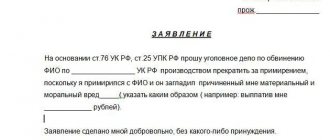Sometimes individuals have to write a statement to initiate a criminal case, but not everyone knows how to do this correctly. A few months ago I became a victim of scammers. In order to punish criminals as they deserved, it was necessary to write a corresponding complaint against them and submit it to the head of the police department for consideration.
[sc:docObr id=»https://grazhdaninu.com/wp-content/uploads/2018/12/obrazets-zayavleniya-o-vozbuzhdenii-ugolovnogo-dela.doc» mytext=»statements to initiate a criminal case»]
I did so, but the document was considered to have no legal force. In this regard, I had to contact a lawyer and find out what should be indicated in statements of this kind and in what order, as well as what details are necessary in the document. This is exactly what I will talk about in this article.
Sample application to initiate a criminal case
Every document that has legal force must be drawn up in compliance with certain rules. The application is no exception. In addition, before demanding that a criminal case be initiated against a certain individual, it is necessary to collect sufficient evidence to confirm his guilt.
It is also necessary to make sure that the defendant’s offense is indeed subject to criminal liability. In addition, you need to find the legislative act whose provisions were violated. You will also need basic information about the individual who is being denounced.
It is recommended to draw up a document requiring the initiation of a criminal case only if the applicant is firmly convinced that the defendant has violated the provisions of the Criminal Code and has the appropriate evidence.
Where to start document preparation
First of all, the application must indicate general information about the individual who issued it, as well as about the recipient. This is done in a specially designated part of the sheet - in the upper right corner. First, you need to register information about the individual for whose consideration the document will be submitted.
The first line displays the position in the dative case (for example, the head of the police department). In addition, the department number is indicated. The next line begins with the official name of the unit headed by the addressee (for example, the Ministry of Internal Affairs for the city of St. Petersburg).
After this, personal data is registered, namely the surname, name and patronymic of the individual. Then the same personal information is entered on a new line about the applicant. In addition, it is necessary to write down the exact coordinates of his place of residence. It also displays a telephone number where you can contact the person requesting that criminal proceedings be initiated. Please note that last names, first names and patronymics must exactly match the passport data.
Required components of the application
After the “header” of the document is completed, you will need to write an important block, without which the document will be considered invalid. This is a phrase confirming the applicant's awareness of the liability for giving false information. In order to avoid slander against law-abiding citizens, article number 306 was introduced into the current Criminal Code. This legislative act specifies the penalties facing individuals guilty of knowingly making false denunciations.
Immediately after the general information about the addressee and addressee, it is necessary to write on a new line that the applicant is familiar with the legislative act on giving false testimony. Be sure to indicate the number of this article (306 from the Criminal Code of the Russian Federation). In addition, the individual must confirm the authenticity of the written phrase by affixing a personal signature. Next, on a new line (in the middle), the type of document is displayed - an application, and under it the name is written (also in the center of the line) - about the initiation of a criminal case.
Mandatory details also include the applicant’s signature along with a transcript (implies the writing of the surname and initials) and the date of execution of the document. These details are indicated at the bottom of the document.
How to compose the main part
It is very important to correctly, concisely and consistently state in the document the events that the applicant considers a violation of the norms of the current Criminal Code. First of all, the surname, full name and patronymic of the offender, as well as the type of violation, are entered in the document. For example, Artem Sergeevich Ivanov committed a robbery. The following are all other important details directly related to the offense:
- Time and place. It is very important to include in the document the day, month and year when the crime was committed, as well as the time. If the victim does not know the exact time, then it is indicated approximately. This information will help check whether the suspected individuals have an alibi. In addition, you need to write down the exact coordinates of the place where this adverse event occurred. If the applicant does not have information of this kind (for example, he noticed only after some time that some personal item was missing), then this should also be written in the application.
- Circumstances. The statement also states all important circumstances related to the crime. For example, a situation is described that was conducive to committing an offense (for example, a thief gained confidence, found out information about when the owner would be absent from the apartment, and committed theft). If the victim knows the motives that prompted the defendant to commit a violation, then they should also be indicated. Sometimes it will be useful to identify the form of relationship between the applicant and the criminal.
- Proof. In order for an individual trying to prosecute a defendant not to be considered an unfounded person, evidence is needed. If the applicant provides material evidence, then his request to initiate a criminal case will be satisfied as soon as possible. It is also possible to involve individuals who witnessed the crime in the case. If the evidence is an audio recording with poor audibility, then a transcript must be attached to it.
- Additional details. Since each type of crime is individual and has its own characteristics, in some cases it may be necessary to write additional details in the application. For example, if a group robbery occurs, then the identities of all accomplices need to be identified. If the criminal had any special characteristics, then this fact can also be recorded in the statement.
From the next paragraph, all that remains is to correctly state the main request of the document. An individual must write that, based on the text he has written above, he demands that a criminal case be initiated. Then the last name, first name and patronymic of the person against whom this must be done is displayed.
It also happens that the applicant does not know the identity of the criminal. In such cases, the document states that the identity of the attacker is unknown. If the criminal did not act alone, then personal information about each of the accomplices is listed in the form of a numbered list (you need to start with the organizer).
Purpose of the application
There are many sources from which law enforcement agencies obtain information about crimes committed. These sources include:
- applications from citizens and legal entities;
- mass media;
- messages from emergency medical services;
- own operational information of the police and prosecutor's offices;
- detention at the scene of a crime, etc.
All these sources are equivalent. That is, no matter where the information about a crime comes from, the actions of law enforcement agencies will be the same - the information will be registered and transferred for study to establish the fact of a crime.
That is why there are not and cannot be any requirements regarding the form of citizens’ application to initiate a criminal case. This means that a person sending a statement to law enforcement agencies about a crime committed is not subject to any restrictions regarding the execution of the statement.
If you wish, you can contact a lawyer who, for a fee, will draw up a statement comparable in volume and number of references to the Criminal Code and the Code of Criminal Procedure to the indictment.
However, it should be borne in mind that a statement that only says “put my neighbor Ivan Ivanovich Ivanov in prison because he stole a rake and a chainsaw from me” will be accepted and considered in the same way as a statement drawn up by a lawyer. Both versions of the statement will equally convey to law enforcement agencies the fact that a crime has been committed.
Main conclusions
- A document requesting to initiate a criminal case must be drawn up only if the applicant is absolutely sure of the guilt of a certain individual.
- The structure of the document is standard - “header”, main part and details.
- The applicant must indicate that he is aware of giving false testimony on the basis of Article 306 of the Criminal Code of the Russian Federation.
- The text of the document indicates the circumstances under which the violation of criminal norms was committed, the place where it occurred, as well as the time.
- The applicant must have evidence confirming that the text he wrote is not unfounded.
Statements by way of private prosecution
A special niche is occupied by applications to initiate a criminal case sent to the court as a private prosecution (Article 20, Part 2 of the Code of Criminal Procedure of the Russian Federation).
These statements require detailed motivation, which is due to the fact that the role of the prosecutor in this category of cases belongs not to the prosecutor, but to the victim.
Applications for private prosecution are sent not to the police or prosecutor's office, but to the magistrate, which means they must be drawn up in accordance with the requirements for going to court.
Thus, a statement of private prosecution must contain:
- name of the court;
- Full name, address and contact details of the applicant;
- Full name, address and contact details of the accused;
- a detailed description of the event that the applicant regards as a crime, and the qualification of the actions of the accused under a specific article of the Criminal Code;
- a list of documents attached to support the accusation and a list of witnesses to be summoned to court;
- date of application and signature of the applicant.
You can read more about preparing this type of statement here.
Do you need motivation?
There is no need to delve into the intricacies of criminal law, much less to qualify the actions of the accused in a statement to initiate a criminal case (except for statements of private prosecution).
In any case, the motivation for the statement will not in any way affect the decision made by law enforcement agencies.
You should not be afraid of “horror stories” about criminal prosecution for false denunciation. This can only happen if the fact referred to in the statement did not occur at all and the applicant reliably knew about it. That is, it will be possible to prosecute for false denunciation only if the applicant simply made up the accusation.
How to write a requirement
There is no single form of such a document that is mandatory for use, so employers draw it up in any form.
The document must contain the following information:
- the name of the company where the offending employee works;
- to whom the letter is addressed (full name and position of the employee);
- postal address if the request is sent by mail;
- Title of the document;
- if desired, contact an employee;
- the essence of the offense;
- link to article 193 of the Labor Code of the Russian Federation and information that the employee must respond within 2 working days;
- a request for a written explanation;
- deadline for providing an explanation to the employer;
- an application, for example, a memo from the head of the department where the employee works;
- date of writing the request;
- employer's signature;
- a column for the employee’s signature and the date when he received the notification.
The employee may not agree to sign for review of the document. In this case, you can send it to him by mail with a notification of receipt or read it out loud in front of a specially convened commission. In the latter case, a corresponding act is drawn up.
For your information! In large companies, of course, it is not the employer himself who draws up the requirements. This can be done by a personnel employee or the boss of the “violator”.
Referral methods
An application to initiate a criminal case may be sent to law enforcement agencies:
- in person by submitting an application to the police officer on duty or to the prosecutor’s office;
- by mail;
- orally. In this case, the police department duty officer will enter the application into a special journal and issue the applicant with a coupon for accepting the application.
You can also contact the prosecutor or his assistant on duty directly. In this case, immediately at the time of receiving the application, the prosecutor will take the explanations from the applicant.
When is such a requirement necessary and why?
An employer can demand an explanatory statement from an employee only in cases where there has been a violation of labor legislation:
- non-compliance with labor safety standards;
- being late for work;
- absence from work for 4 hours or more;
- appearing at the workplace in a state of intoxication (meaning drugs and alcohol);
- damage to the tenant's property.
The employer can demand an explanation either orally or in writing. However, a written demand is preferable as it will serve as evidence that it was actually made and an explanation was sought. In addition, such a document records the date of the disciplinary offense and indicates by what time the employee must give written explanations. 2 working days are given for this.
If an employee truly values his job, then it is in his best interest to provide an explanation. The employer must understand what his further actions are, so an explanatory statement from the employee is necessary. But if he never provides it, then this should not be interpreted as evidence of the employee’s guilt in a particular incident.
To whom should the application be addressed?
The initiation and investigation of criminal cases is the prerogative of law enforcement agencies, so a statement can be sent to both the police and the prosecutor's office, or even both of these bodies at the same time.
It is advisable that the police department or prosecutor's office geographically correspond to the place where the application was written.
However, there are no restrictions on filing applications with higher territorial authorities. That is, a statement regarding a fact that took place, for example, in Saratov, can be sent to the General Prosecutor's Office of the Russian Federation or the Ministry of Internal Affairs of the Russian Federation. In this case, you can be sure that in the end the application will end up where it should have gone initially.
This is explained by the fact that the prosecutor’s office and the Ministry of Internal Affairs are a strict hierarchical structure of vertical subordination.






